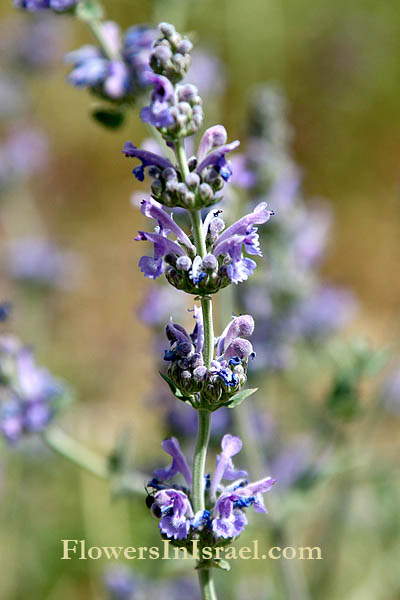Hebrew: נפית כפופה, Arabic: "za'tar chachla"
| Scientific name: | Nepeta curviflora Boiss. | |
| Common name: | Syrian Catnip | |
| Hebrew name: | נפית כפופה | |
| Arabic name: | "za'tar chachla" | |
| Family: | Labiatae Lamiaceae, שפתניים |

|
| Life form: | Chamaephyte, semi-shrub | |
| Stems: | Erect, square; 60-80 cm high | |
| Leaves: | Opposite, entire, dentate or serrate | |
| Inflorescence: | Verticillasters grouped on spikes | |
| Flowers: | Tubular dark blue flowers | |
| Fruits / pods: | Nutlets | |
| Flowering Period: | April, May, June | |
| Habitat: | Batha, Phrygana | |
| Distribution: | Mediterranean Woodlands and Shrublands, Montane vegetation of Mt. Hermon | |
| Chorotype: | Mediterranean | |
| Summer shedding: | Perennating |

Derivation of the botanical name: Nepeta, named in honor of the Etruscan city Nepeta, and is said to have been given because the plant was common round the town of Nepet; Nepeta (Ptol., Strab.) Nepet (Plin., Liv.) Nepe (Peut.). curviflora, curvus, "crooked, curved, bent", florus, flor, floreo, "to bloom, to flower"; curved flower. The Hebrew name: נפית, Nepit, translation and transliteration from the scientific name Nepeta.
Catnip contains nepetalactone, a terpene, that is thought to mimic feline sex pheromones. Cats detect it through their vomeronasal organs. When cats sense the bruised leaves or stems of catnip, they will rub in it, roll over it, paw at it, chew it, lick it, leap about, then purr loudly, growl, and meow. This reaction only lasts for several minutes before the cat loses interest. It takes up to two hours for the cat to "reset" and then it can come back to the catnip and have the same response as before. |